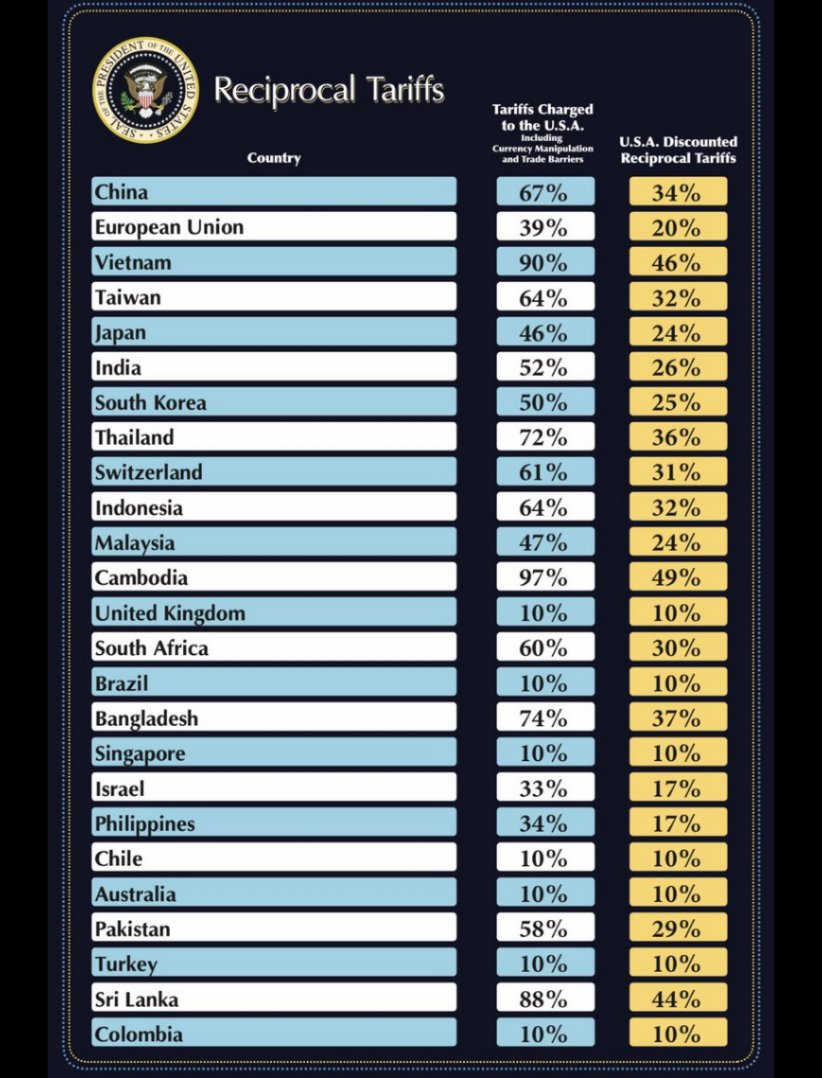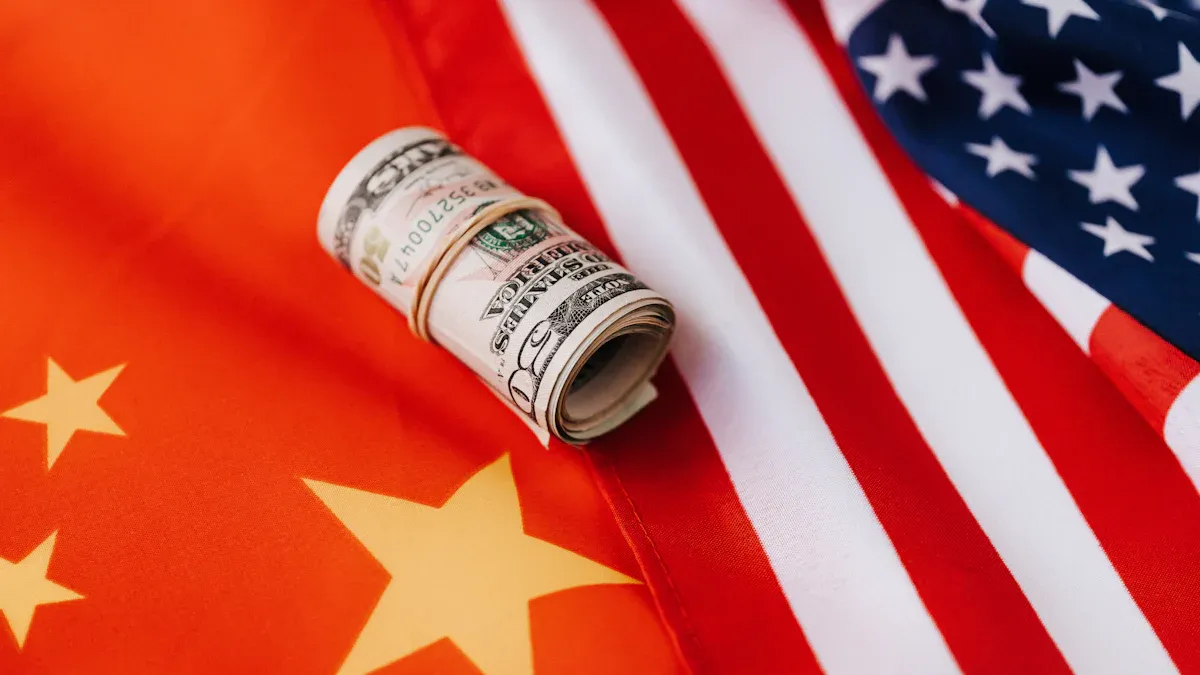Trump's Reciprocal Tariff Policy Sparks Global Trade Tensions and Domestic Industry Challenges

The Trump administration implemented a new Reciprocal Tariff Policy that includes a 10% tax on imports. This policy aims to address unfair trade practices by creating a more balanced trading environment. The U.S. frequently purchases more from other countries than it exports, contributing to a trade deficit that has improved from 6% before the Great Recession to 3% currently. However, there are ongoing concerns about the sustainability of this improvement.
This Reciprocal Tariff Policy has generated challenges both globally and within the U.S. A 10% increase in global tariffs could potentially reduce the world’s economy by 3% over the next two years. In the U.S., sectors such as automotive and electronics are experiencing higher production costs, with expenses rising by 10%. Additionally, car imports have decreased by 15%. These developments have sparked debates regarding whether Trump’s tariffs are beneficial or detrimental to global trade.
Key Takeaways
Trump's Reciprocal Tariff Policy adds a 10% tax on imports. This is meant to make trade fairer and help U.S. businesses.
Higher tariffs mean higher prices for shoppers. Everyday items now cost more, making it tough for families to buy what they need.
Other countries hit by U.S. tariffs are fighting back with their own taxes. This has made global trade arguments worse and hurt relationships between nations.
The trade war is messing up how goods are made and delivered worldwide. Companies must find new suppliers, which costs money and takes time.
Over time, the trade war might slow down the world economy. It could also change how countries trade and create new partnerships.
Key Features of the Reciprocal Tariff Policy
Basic and Special Tariffs
The Reciprocal Tariff Policy sets a 10% tax on imports. This aims to help U.S. industries compete fairly. Some countries face higher, special tariffs. For instance, imports from China have a 34% tariff. This adds to the earlier 20% tax, making it 54% total. Vietnam faces a 46% tariff, while India and Japan have 26% and 24%, respectively.
The table below shows the tariff rates for major trade partners:
Country/Region | Tariff Rate | Notes |
|---|---|---|
Vietnam | 46% | |
China | 34% | Adds to earlier 20% February tax (54% total) |
India | 26% | |
Japan | 24% | |
European Union | 20% | Applies to all EU countries |
Brazil | 10% | |
Colombia | 10% | |
United Kingdom | 10% | |
Canada/Mexico | 0 / 25% | 0% for USMCA goods, 25% for others |
These special tariffs aim to fix trade problems with certain nations.
Exemptions and Why They Matter
Exemptions are an important part of this policy. They let some countries or industries avoid tariffs if they meet certain rules. For example, Canada and Mexico pay 0% on USMCA goods but 25% on others. This encourages following trade deals and helps key industries.
The table below explains why exemptions are important:
Type of Information | Description |
|---|---|
Sector(s) | Industries like farming and energy benefit from exemptions. |
Measure | Exemptions ensure trade deals like USMCA are followed. |
Countries | Canada, Mexico, and others get exemptions. |
Duration | Exemptions last until trade deals are updated. |
Conditions | Following specific trade rules is required. |
Exemptions help balance protecting U.S. industries with working with other countries.
Timeline and Important Dates
The Reciprocal Tariff Policy was announced in early 2023. It is being rolled out in steps during the year. In February 2023, extra tariffs on China began. In July 2023, exemptions for USMCA goods started. The full policy will be in place by the end of 2023.
This timeline shows the careful planning to help industries adjust.
Global Trade Tensions and International Reactions

Criticism from Global Leaders and Economists
Many leaders and experts dislike the Reciprocal Tariff Policy. They say it hurts trade and causes economic problems. Tariffs have lowered global GDP by 1%, or $300 billion. Prices for goods went up by 9.5%, but wages rose only 8.6%. Real wages dropped, making life harder for poorer families.
Economists warn that protectionism from tariffs could last for decades. Tariff costs are passed to buyers, raising yearly household spending by 3%. This hits all income levels but affects poorer families the most.
Retaliatory Measures by Affected Nations
Countries hit by U.S. tariffs are fighting back with their own tariffs. Canada added a 25% tariff on U.S. goods worth $105 billion starting February 4, 2025. China set a 10% tariff on some items beginning February 10, 2025. Mexico used both tariffs and other trade rules, making things more difficult.
These actions have worsened the trade war, causing more problems for global trade. The European Union also changed its trade rules to respond to U.S. tariffs, showing a shift in trade worldwide.
Country | Retaliatory Measure Description | Value (USD) | Effective Date |
|---|---|---|---|
Canada | 25% tariff on U.S. goods | 105 billion | February 4, 2025 |
Mexico | Tariff and non-tariff measures | N/A | N/A |
China | 10% tariff on various products | N/A | February 10, 2025 |
Predicted Disruptions to Global Supply Chains
The trade war is messing up global supply chains. Companies are changing suppliers to avoid relying on certain regions like China. This costs a lot and takes time.
Raw materials and factories are concentrated in a few countries, which is risky. U.S.-China tariffs have already lowered trade between them. Political tensions make it harder for businesses to adjust supply chains.
Evidence Type | Description |
|---|---|
Supply Chain Adjustments | Companies are diversifying supply chains. |
Trade Reduction | U.S.-China tariffs have reduced trade volume. |
Market Concentration Risks | Concentration of resources threatens stability. |
Trade and politics are closely linked, making balance important. Without balance, the global economy could face big problems.
Domestic Industry Challenges Under Trump Tariffs

Impact on the Automotive Sector
The car industry is struggling because of the tariffs. Higher taxes on steel and aluminum have raised costs for carmakers. These materials are needed to build cars, so the impact is big. For example, U.S. carmakers now spend 10% more to make vehicles. Companies must either pay these costs or charge buyers more. This has made new cars more expensive, so fewer people can afford them.
The tariffs have also caused problems with getting parts. Many carmakers get parts from other countries. The higher taxes make importing these parts cost more. This has caused delays and raised expenses. Some companies have cut production or moved factories to other countries, making things worse.
Supply Chain Reshoring and Feasibility Concerns
Bringing supply chains back to the U.S. is now a focus. But this is hard to do. Building new factories in the U.S. takes a lot of money and time. Industries like carmaking and electronics also struggle to find skilled workers and materials here.
Steel and aluminum production show these problems. In 2023, steel production dropped to 75.3%, down from 80% in 2021. Aluminum production got better, reaching 55% in 2023 compared to 40% in 2017. Even with these changes, the U.S. still doesn’t make enough, so companies must import.
Year | Steel Production Rate | Aluminum Production Rate |
|---|---|---|
2021 | 80% | N/A |
2022 | 77.3% | N/A |
2023 | 75.3% | 55% |
2017 | N/A | 40% |
2019 | N/A | 61% |
These numbers show how hard it is to bring supply chains back while keeping costs low.
Lobbying Efforts and Industry Pushback
Industries are fighting back against the tariffs by lobbying. The drug industry group PhRMA is a strong example. They make $450 million a year and have 160 lobbyists. But recent political changes have made their work harder, showing weaknesses in their efforts.
Other industries are also speaking out about the tariffs. They say higher costs hurt both businesses and buyers. Lobbying groups want the government to rethink the policy. They ask for a fair plan that helps industries without hurting consumers.
PhRMA earns $450 million yearly and has 160 lobbyists.
Political changes have made their work more difficult.
Industries say tariffs harm both businesses and buyers.
These lobbying efforts show how many groups are trying to reduce the negative effects of the tariffs.
Long-Term Effects of the Trade War
Risks to Global Economic Recovery
The trade war is slowing global economic recovery. Tariffs make prices rise, so people can buy less. For example, U.S. inflation might go up by 2%. This makes everyday items cost more. The U.S. economy may grow less than 1% this year. A recession could even shrink the economy by 1%.
Other problems, like political conflicts and long trade fights, make things worse. These issues upset markets and confuse businesses. Low-interest rates might also make assets too expensive, causing risks. To help, the Federal Reserve might lower rates by 0.75-1%. This could support growth and fix job market problems.
The trade war affects more than just the U.S. Europe’s growth might slow by 0.5-1%. Asian countries, which depend on trade, could see growth drop to 4% or less. These numbers show how the trade war hurts global recovery.
Changes in International Trade Relations
The trade war is changing how countries trade with each other. Nations are rethinking their deals to rely less on the U.S. and China. This could lead to new trade groups and partnerships. For example, Asian and European countries might work together more to avoid U.S. tariffs.
China is also changing its plans. It is trading more with Africa and South America. These moves could shift global trade power. Smaller economies might become more important in the future.
It’s unclear what these changes will mean long-term. But they might create a world where countries focus more on local trade than global teamwork.
Effects on Global Supply Chains
The trade war is causing problems for supply chains worldwide. A survey showed 73% of manufacturers worry about trade issues like tariffs. Many companies are finding new suppliers to avoid relying on places like China.
This is expensive and takes time. Tariffs on key goods have also cut Americans’ spending money by 1% by 2026. With less money, people buy fewer nonessential items. This lowers demand for many products.
Raw materials and factories are often in just a few areas. This makes supply chains risky. Companies must handle these problems carefully to stay stable. These challenges show how connected the global economy is and why fair trade rules are important.
Trump's tariff policy brought big changes to world trade. The average tariff rate rose from 2.5% to 9.0%. It might reach 25% after new rules. In April 2025, 'liberation day' tariffs began. Most imports faced a 10% tax, while 60 countries saw up to 50%. These tariffs tried to fix trade problems but caused economic troubles.
Over time, global trade could change a lot. Countries might team up to depend less on the U.S. Businesses are struggling to adjust supply chains. Balancing support for U.S. industries with global teamwork is key for stability.
What is the goal of the Reciprocal Tariff Policy?
The policy tries to fix trade gaps by taxing imports. It helps U.S. businesses compete fairly and stops unfair trade by other countries.
How do tariffs impact regular shoppers?
Tariffs make imported goods cost more. Companies raise prices on items like cars, gadgets, and food. This makes it harder for families, especially those with less money, to buy things.
Why don’t all countries pay tariffs?
Some countries follow trade rules, like USMCA, so they don’t pay tariffs. These rules help countries work together and keep trade fair for everyone.
How do tariffs mess up supply chains?
Tariffs raise costs and make companies find new suppliers. This takes time and money, causing delays and making things more expensive to produce.
What problems could the trade war cause later?
The trade war might slow the world’s economy and raise prices. Countries could form new groups to trade without the U.S., changing how global trade works.
See Also
Three Key Features of SPC5605BMLL6 and SPC5607BMLL6 ECUs
Three Transformative Impacts of XCF01SVOG20C on Automation
Reasons to Select Coilcraft XPL2010 for VRM/VRD Applications
Ways Innovative Technology Ensures Quality in Electronics
Enhancing Process Control with AD74413RBCPZ Unlocking Techniques
CALL US DIRECTLY
(+86)755-82724686
RM2508,BlockA,JiaheHuaqiangBuilding,ShenNanMiddleRd,Futian District,Shenzhen,518031,CN
www.keepboomingtech.com sales@keepboomingtech.com
